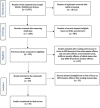A systematic review on occupational hazards, injuries and diseases among police officers worldwide: Policy implications for the South African Police Service
- PMID: 30679940
- PMCID: PMC6341669
- DOI: 10.1186/s12995-018-0221-x
A systematic review on occupational hazards, injuries and diseases among police officers worldwide: Policy implications for the South African Police Service
Abstract
Background: Occupational hazards, injuries and diseases are a major concern among police officers, including in Sub-Saharan Africa. However, there is limited locally relevant literature for guiding policy for the South African Police Service (SAPS). The purpose of this review was to describe the occupational hazards, injuries and diseases affecting police officers worldwide, in order to benchmark policy implications for the SAPS.
Methods: We conducted a systematic review of studies using Google Scholar, PubMed and Scopus.
Results: A total of 36 studies were included in this review. Six revealed that police officers' exposure to accident hazards may lead to acute or chronic injuries such as sprains, fractures or even fatalities. These hazards may occur during driving, patrol or riot control. There were two studies, which confirmed physical hazards such as noise induced hearing loss (NIHL), due to exposure to high levels of noise. Three studies on chemical hazards revealed that exposure to high concentrations of carbon dioxide and general air pollution was associated with cancer, while physical exposure to other chemical substances was linked to dermatitis. Four studies on biological hazards demonstrated potential exposure to blood borne diseases from needle stick injuries (NSIs) or cuts from contaminated objects. One study on ergonomic hazards showed that musculoskeletal disorders can result from driving long distances and lifting heavy objects. There were 15 studies that indicated psychological hazards such as post-traumatic stress disorder (PTSD) as well as stress. Moreover, four studies were conducted on organizational hazards including burnout, negative workplace exposure and other factors.
Conclusions: This review outlined the global impact of occupational hazards, injuries and diseases in the police force. It served as a benchmark for understanding the policy implications for South Africa, where there is paucity of studies on occupational health and safety.
Keywords: Occupational hazards; Occupational health and safety; Occupational injuries; Police and occupational diseases; Stress; Work injury.
Conflict of interest statement
GGM is currently studying towards a PhD in the University of KwaZulu-Natal, with research focus on the “occupational health and safety among police officers in the Gauteng province of South Africa”. MJC is a Research Professor at the University of KwaZulu-Natal’s College of Health Sciences and has supervised a number of PhD students. CH is a Deputy Executive Director at the Research Use and Impact Assessment, Human Sciences Research Council and has also supervised a number of PhD students in different fields.The authors declare that they have no competing interests in this section.Springer Nature remains neutral with regard to jurisdictional claims in published maps and institutional affiliations.
Figures






Similar articles
-
Occupational Health Hazards Among Traffic Police in South Asian Countries: Protocol for a Scoping Review.JMIR Res Protoc. 2023 Mar 8;12:e42239. doi: 10.2196/42239. JMIR Res Protoc. 2023. PMID: 36884285 Free PMC article.
-
Prevalence and correlates of needle-stick injuries among active duty police officers in Tijuana, Mexico.J Int AIDS Soc. 2016 Jul 18;19(4 Suppl 3):20874. doi: 10.7448/IAS.19.4.20874. eCollection 2016. J Int AIDS Soc. 2016. PMID: 27435711 Free PMC article.
-
Burnout and Stress Measurement in Police Officers: Literature Review and a Study With the Operational Police Stress Questionnaire.Front Psychol. 2020 May 7;11:587. doi: 10.3389/fpsyg.2020.00587. eCollection 2020. Front Psychol. 2020. PMID: 32457673 Free PMC article.
-
Systematic review of posttraumatic stress disorder in police officers following routine work-related critical incident exposure.Am J Ind Med. 2020 Jul;63(7):600-615. doi: 10.1002/ajim.23120. Epub 2020 May 17. Am J Ind Med. 2020. PMID: 32419181
-
Occupational hazard in Malaysian traffic police: special focus on air pollutants.Rev Environ Health. 2021 Feb 17;36(2):167-176. doi: 10.1515/reveh-2020-0107. Print 2021 Jun 25. Rev Environ Health. 2021. PMID: 33594842 Review.
Cited by
-
Mortality in Brazilian federal highway police officers: time series from 2001 to 2020.Rev Saude Publica. 2022 Sep 16;56:82. doi: 10.11606/s1518-8787.2022056004210. eCollection 2022. Rev Saude Publica. 2022. PMID: 36134778 Free PMC article.
-
Noise-Induced Hearing Loss in Police Officers: Systematic Review.Iran J Otorhinolaryngol. 2022 Sep;34(124):211-218. doi: 10.22038/IJORL.2022.64036.3198. Iran J Otorhinolaryngol. 2022. PMID: 36246192 Free PMC article.
-
Firearm-related suicides, homicides, and homicide-suicides involving security officers in two East African Countries: a press media review.BMC Psychiatry. 2023 Nov 24;23(1):877. doi: 10.1186/s12888-023-05368-6. BMC Psychiatry. 2023. PMID: 38001434 Free PMC article.
-
Unmet medical needs and influencing factors among Korean police officers: a cross-sectional survey.BMJ Open. 2024 Aug 12;14(8):e080494. doi: 10.1136/bmjopen-2023-080494. BMJ Open. 2024. PMID: 39134440 Free PMC article.
-
Asymptomatic Small Airway Obstruction in Nonsmoking Traffic Police Personnel of Central Karnataka: A Comparative Cross-Sectional Study.Indian J Occup Environ Med. 2025 Jan-Mar;29(1):21-24. doi: 10.4103/ijoem.ijoem_282_23. Epub 2025 Mar 31. Indian J Occup Environ Med. 2025. PMID: 40275894 Free PMC article.
References
-
- International Labour Organization. Safety and Health at Work. Geneva: International Labour. Office. 2016. Retrieved from http://www.ilo.org/global/topics/safety-and-health-at-work/lang--en/inde....
-
- Alexanderson K, Svedberg PIA, Ko J. Sickness absence among women and men in the police: A systematic literature review. Scand J Public Health. 2009;5:30–35. - PubMed
-
- Goldstein G, Helmer M, Fingerhut R, Organisation IL, FI of O H, Goldstein G, et al. African Newsletter on Occupational Health and Safety. In. Finland: Finnish Institute of Occupational Health, vol. 11; 2001.
Publication types
LinkOut - more resources
Full Text Sources

